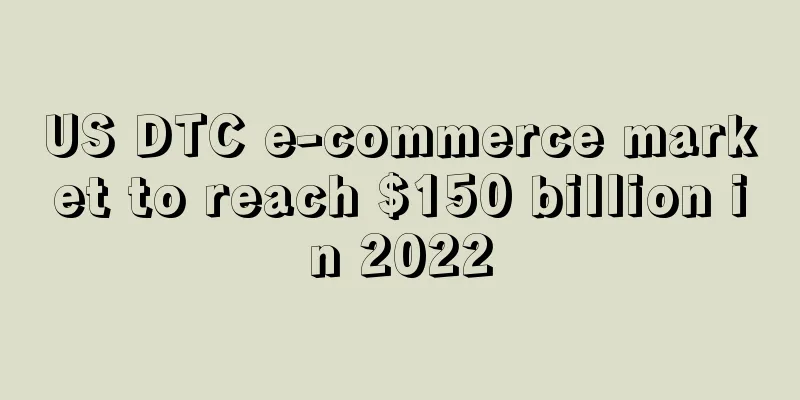US DTC e-commerce market to reach $150 billion in 2022

|
According to eMarketer's forecast, US direct-to-consumer (DTC) e-commerce sales will reach $151.2 billion in 2022, a 16.9% increase compared to this year. In the coming year, although DTC purchases will only account for 2.5% of total retail sales, these brands will successfully subvert the traditional retail industry through diversified consumer experiences .
Pure DTC companies attract consumers through intentional marketing. For DTC companies , customer acquisition costs can also be high , but the DTC model can provide companies with marketing control over each product .
Shane Pittson, Quip’s vice president of growth, told eMarketer that as a DTC company , the oral hygiene supplier can gain better “data and insights” in conversations with retailers to position itself for successful product launches .
It is understood that providing customers with unique, high-quality products is the ultimate goal of every DTC company . As products are provided directly to customers, each DTC faces the challenge of convincing customers that what it offers is something that consumers cannot find elsewhere.
For Ricky Joshi, co-founder and chief strategy officer of mattress company Saatva, that means avoiding the bells and whistles surrounding typical DTC brands and instead “ staying true to the value proposition and the philosophy that the company was started with.”
At the same time, like every e-commerce company, DTC faces the challenge of converting likes into actual purchases . How to improve the ability to convert "add to cart" into " consumer checkout " ? The strategy to drive consumers to open their wallets is different for each DTC .
Kate MacCabe, vice president of product at Brooklinen, told eMarketer that the bedding company has actually benefited from its DTC brand , simplifying the path to purchase in the process. For other DTCs , improving conversion rates may require partnerships with companies like Shopify.
Beyond that, to remain competitive, DTCs must diversify the consumer experience and evolve with customer needs, rather than just selling fixed products on a website. For many DTCs , this means moving beyond the pure DTC model and partnering with external resources in the spirit of growth.
For example, shoe brand Allbirds and eyewear purveyor Warby Parker have physical stores that bring customers offline. Quip partners with existing brick-and-mortar stores, such as Target, to sell its products.
Meanwhile, many DTC companies have expanded beyond their initial hit products . Allbirds now sells apparel , while Harry’s , a company that primarily sells men’s razors , also offers deodorant . This reflects the shift in these brands’ models while still sticking to their value propositions . USA DTC D2C |
<<: Pet Circle, a pet e-commerce platform, received $125 million in financing
>>: Watco children's bathrobes recalled due to flammability risk!
Recommend
What is Darfon Logistics? Darfon Logistics Review, Features
Darfon Logistics (Shenzhen Darfon Logistics Co., ...
Fast fashion will recover in 2022, with e-commerce becoming an important driving force
Fast fashion has had a rough few years, but has r...
Shipping prices fall to 5 yuan! Sellers' prices are going to skyrocket during the peak season
It is the peak season for stocking up, but a Shen...
US-based TryNow raises $12 million to enhance user experience
San Francisco-based TryNow said it has raised $12...
What is Sahibinden? Sahibinden Review, Features
Founded in 2000, Sahibinden is an online classifie...
What is Paya Payments? Paya Payments Review, Features
Paya Payments makes payments easier, providing in...
What is Selling Manager Pro? Selling Manager Pro Review, Features
Selling Manager Pro is a paid monthly service tha...
What is Shenzhen Tianhe Overseas Technology? Shenzhen Tianhe Overseas Technology Review, Features
Shenzhen Tianhe Overseas Technology ’s one-stop c...
What is Wise Express? Wise Express Review, Features
Wanse Express (Shanghai Wanse Express Co., Ltd.) w...
What is IPCN Cross-border Intellectual Property? IPCN Cross-border Intellectual Property Review, Features
IPCN Cross-border Intellectual Property is a profe...
Peruvian online shopping apps are popular, with 73% of buyers choosing Linio for shopping!
With the popularity of the Internet and mobile ap...
Amazon stock performed poorly in 2021, rising only 2.4%!
As a giant in cross-border e-commerce, Amazon'...
What is Demart Trading Co., Ltd.
Demart Trading Co., Ltd. was established on May 2...
Climb to BSR! Small home appliances make big money overseas
As an advantageous export category, more and more...
What is Petal? Petal Review, Features
Petal is an American credit card and loan company...









